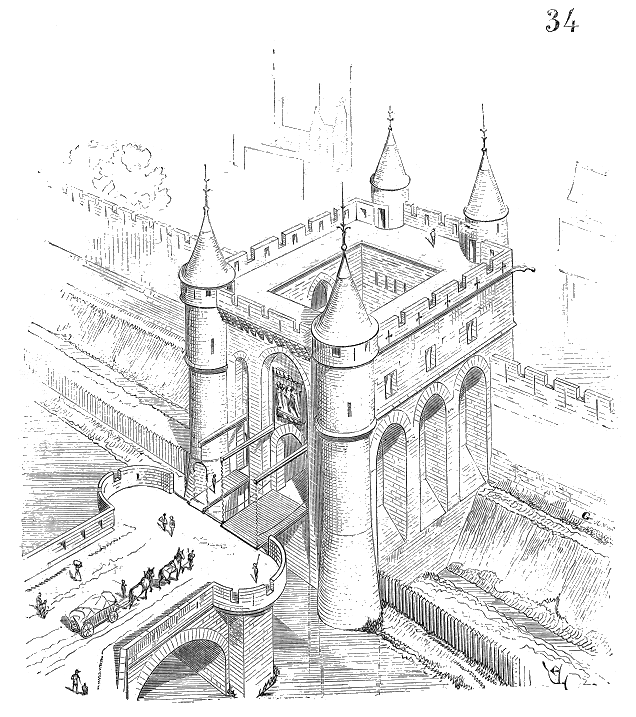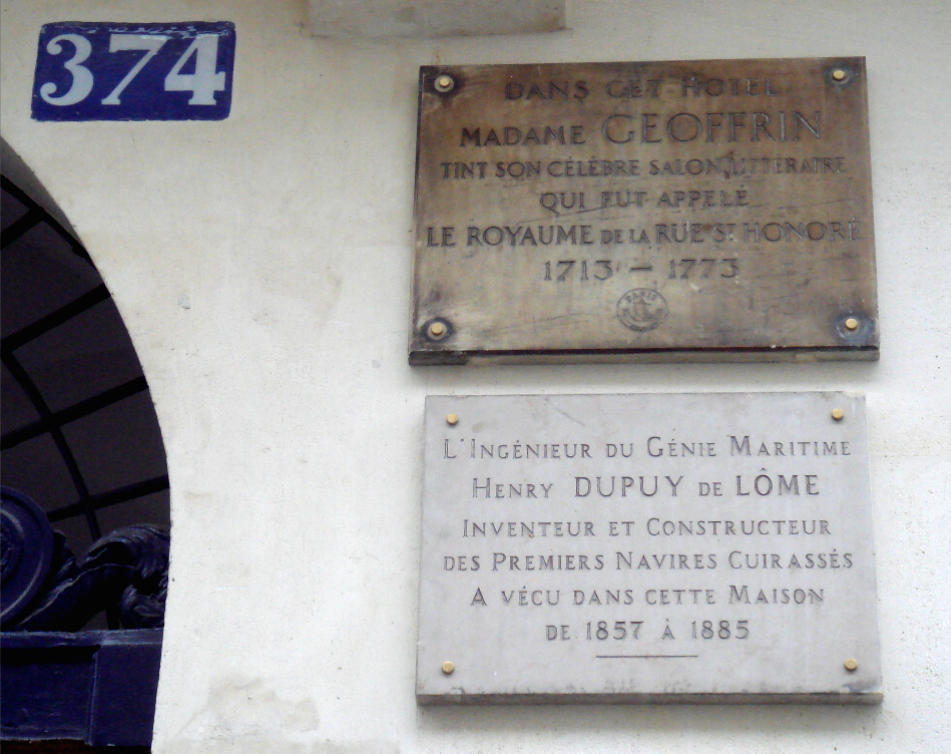|
Porte Saint-Honoré
Porte Saint-Honoré was a city gate in Paris. It was the main entry point into the city from the west, towards Saint-Germain-en-Laye (with porte Saint-Denis to the north towards Saint-Denis, Seine-Saint-Denis, Saint-Denis, porte Saint-Antoine to the east towards Vincennes, and to the south towards Orléans). There were three gates that bore the name, demolished rebuilt further and further along rue Saint-Honoré as the city expanded - they dated to the early 13th, late 14th and early 17th centuries. Bibliography *Jacques Hillairet, ''Connaissance du vieux Paris : rive droite, rive gauche, les îles & les villages'', Paris, éditions Payot & Rivages, 1993 (1re éd. 1956), 3 t. en 1 vol. , 377-299-255 p. (). *Renaud Gagneux and Denis Prouvost, ''Sur les traces des enceintes de Paris : promenade au long des murs disparus'', Paris, éditions Parigramme, 2004, 246 p. (). {{DEFAULTSORT:Porte Saint-Honore category:City gates in Paris, Saint-Honore category:Buildings and structure ... [...More Info...] [...Related Items...] OR: [Wikipedia] [Google] [Baidu] |
Nouvelle Porte Saint-Honor%C3%A9
Nouvelle is a French language, French word, the feminine form of "new". It may refer to: ;Places * Nouvelle, Quebec, a municipality in Quebec, Canada * Nouvelle-Église, a commune in the Pas-de-Calais department, France * Port-la-Nouvelle, a commune in the Aude department, France ;Other * Nouvelle, the French name for a novella * Nouvelle AI, an approach to the artificial intelligence in the 1980s * Nouvelle Chanson, a musical genre which emerged in France in the 1990s * ''Battle of the Brave (Nouvelle-France)'', a 2004 historical romance film directed by Jean Beaudin * Nouvelle histoire, a French historiographic current from the 1970s * Nouvelle Planète, a Swiss non-profit organization * Nouvelle Star, a French television series based on the Pop Idol programme * Nouvelle Tendance, an art movement founded in Yugoslavia in 1961 * Nouvelle Vague, informal denomination of a movement of French filmmakers of the late 1950s and 1960s * ''La Nouvelle Tribune'', a weekly francophone Moro ... [...More Info...] [...Related Items...] OR: [Wikipedia] [Google] [Baidu] |
Paris
Paris () is the capital and most populous city of France, with an estimated population of 2,165,423 residents in 2019 in an area of more than 105 km² (41 sq mi), making it the 30th most densely populated city in the world in 2020. Since the 17th century, Paris has been one of the world's major centres of finance, diplomacy, commerce, fashion, gastronomy, and science. For its leading role in the arts and sciences, as well as its very early system of street lighting, in the 19th century it became known as "the City of Light". Like London, prior to the Second World War, it was also sometimes called the capital of the world. The City of Paris is the centre of the Île-de-France region, or Paris Region, with an estimated population of 12,262,544 in 2019, or about 19% of the population of France, making the region France's primate city. The Paris Region had a GDP of €739 billion ($743 billion) in 2019, which is the highest in Europe. According to the Economist Intelli ... [...More Info...] [...Related Items...] OR: [Wikipedia] [Google] [Baidu] |
Saint-Germain-en-Laye
Saint-Germain-en-Laye () is a commune in the Yvelines department in the Île-de-France in north-central France. It is located in the western suburbs of Paris, from the centre of Paris. Inhabitants are called ''Saint-Germanois'' or ''Saint-Germinois''. With its elegant tree-lined streets it is one of the more affluent suburbs of Paris, combining both high-end leisure spots and exclusive residential neighborhoods (see the Golden Triangle of the Yvelines). Saint-Germain-en-Laye is a sub-prefecture of the department. Because it includes the National Forest of Saint-Germain-en-Laye, it covers approximately , making it the largest commune in the Yvelines. It occupies a large loop of the Seine. Saint-Germain-en-Laye lies at one of the western termini of Line A of the RER. History Saint-Germain-en-Laye was founded in 1020 when King Robert the Pious (ruled 996–1031) founded a convent on the site of the present Church of Saint-Germain. In 1688, James II of England exiled hi ... [...More Info...] [...Related Items...] OR: [Wikipedia] [Google] [Baidu] |
Porte Saint-Denis
The Porte Saint-Denis ( en, St. Denis Gate) is a Parisian monument located in the 10th arrondissement, at the site of one of the gates of the Wall of Charles V, one of Paris' former city walls. It is located at the crossing of the Rue Saint-Denis continued by the Rue du Faubourg Saint-Denis, with the Boulevard de Bonne-Nouvelle and the Boulevard Saint-Denis. History The Porte Saint-Denis was originally a gateway through the Wall of Charles V that was built between 1356 and 1383 to protect the Right Bank of Paris. The medieval fortification had two gates and was surmounted with four towers. Additional portcullises defended the outer gate along with a drawbridge and rock-cut ditch. However, with the advent of gunpowder and the development of cannons and bombards, the walls were eventually partly torn down in the 1640s to make way for the larger and more fortified Louis XIII Wall. In the 1670s, the remaining walls of Charles V were entirely demolished when Paris spread beyond t ... [...More Info...] [...Related Items...] OR: [Wikipedia] [Google] [Baidu] |
Saint-Denis, Seine-Saint-Denis
Saint-Denis (, ) is a commune in the northern suburbs of Paris, France. It is located from the centre of Paris. Saint-Denis had a population of 112,091 as of 2018. It is a subprefecture (french: sous-préfecture) of the department of Seine-Saint-Denis, being the seat of the arrondissement of Saint-Denis. Saint-Denis is home to the royal necropolis of the Basilica of Saint-Denis and was also the location of the associated abbey. It is also home to France's national football and rugby stadium, the Stade de France, built for the 1998 FIFA World Cup. Saint-Denis is a formerly industrial suburb currently changing its economic base. Inhabitants of Saint-Denis are called ''Dionysiens''. Name Until the 3rd century, Saint-Denis was a small settlement called ''Catolacus'' or ''Catulliacum'', probably meaning "estate of Catullius", a Gallo-Roman landowner. About 250 AD, the first bishop of Paris, Saint Denis, was martyred on Montmartre hill and buried in ''Catolacus''. Shortly aft ... [...More Info...] [...Related Items...] OR: [Wikipedia] [Google] [Baidu] |
Porte Saint-Antoine
The Porte Saint-Antoine was one of the gates of Paris. There were two gates named the Porte Saint-Antoine, both now demolished, of which the best known was that guarded by the Bastille, on the site now occupied by the start of Rue de la Bastille in the 4th arrondissement of Paris. History The Faubourg One of the oldest routes through Paris, dating to the Roman era, was that through the centre of the city heading for Meaux and Melun. This road began in Paris with what is now the Rue du Pourtour-Saint-Gervais as far as the Porte Baudoyer, the gate into the 5th-century enclosure level with the Rue des Barres and Place Baudoyer. Beyond the city walls, it was known as the Rue Saint-Antoine (including today's Rue François-Miron and Rue des Barres as far as Rue de Fourcy), since it served the Abbaye Saint-Antoine-des-Champs (on the site of today's Hôpital Saint-Antoine, in the 12th arrondissement), founded right at the start of the 13th century. When King Philip II built the Wal ... [...More Info...] [...Related Items...] OR: [Wikipedia] [Google] [Baidu] |
Vincennes
Vincennes (, ) is a commune in the Val-de-Marne department in the eastern suburbs of Paris, France. It is located from the centre of Paris. It is next to but does not include the Château de Vincennes and Bois de Vincennes, which are attached to the city of Paris. History The Marquis de Sade was imprisoned in Vincennes fortress in 1777, where he remained until February 1784 although he escaped for a little over a month in 1778. Thereafter Vincennes fortress was closed and de Sade transferred to the Bastille. In 1821, the noted French poet, Alfred de Vigny, wrote his poem, "La Prison," which details the last days of the Man in the Iron Mask at Vincennes. The ministers of Charles X were imprisoned at the fortress of Vincennes after the July Revolution. A test was conducted in 1849 on Claude-Étienne Minié's invention the Minié ball which would prove successful and years later be adopted by the French army. On the morning of 15 October 1917, famous femme fatale Mata Hari ... [...More Info...] [...Related Items...] OR: [Wikipedia] [Google] [Baidu] |
Orléans
Orléans (;"Orleans" (US) and , ) is a city in north-central France, about 120 kilometres (74 miles) southwest of Paris. It is the prefecture of the Departments of France, department of Loiret and of the Regions of France, region of Centre-Val de Loire. Orléans is located on the river Loire nestled in the heart of the Loire Valley, classified as a Loire Valley, World Heritage Site, where the river curves south towards the Massif Central. In 2019, the city had 116,269 inhabitants within its municipal boundaries. Orléans is the center of Orléans Métropole that has a population of 288,229. The larger Functional area (France), metropolitan area has a population of 451,373, the 20th largest in France. The city owes its ... [...More Info...] [...Related Items...] OR: [Wikipedia] [Google] [Baidu] |
Rue Saint-Honoré
The rue Saint-Honoré is a street in the 1st arrondissement of Paris, France. It is named after the collegial situated in ancient times within the cloisters of Saint-Honoré. The street, on which are located a number of museums and upscale boutiques, is near the Jardin des Tuileries and the Saint-Honoré market. Like many streets in the heart of Paris, the rue Saint-Honoré, as it is now known, was laid out as early as the Middle Ages or before. The street, at one time, continued beyond the former city walls into what was the ''faubourg'' (from Latin ''foris burgem'', an area "outside the city"). This continuation was eventually named the rue du Faubourg Saint-Honoré. History The rue Saint-Honoré has been given the following names in its long history: *The section between the rue de la Lingerie and the rue de la Tonnellerie was named the rue de la Chausseterie from 1300 to the 17th century. *The section between the now extinct rue Tirechappe and the rue de l'Arbre Sec was n ... [...More Info...] [...Related Items...] OR: [Wikipedia] [Google] [Baidu] |





.jpg)
